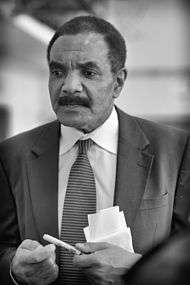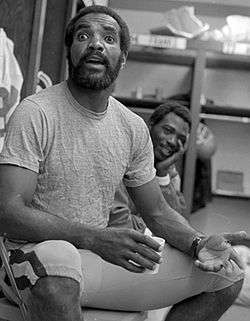Calvin Hill
|
With Cleveland in 1979 | |||||||||
| No. 35 | |||||||||
|---|---|---|---|---|---|---|---|---|---|
| Position: | Running back | ||||||||
| Personal information | |||||||||
| Date of birth: | January 2, 1947 | ||||||||
| Place of birth: | Baltimore, Maryland | ||||||||
| Height: | 6 ft 4 in (1.93 m) | ||||||||
| Weight: | 227 lb (103 kg) | ||||||||
| Career information | |||||||||
| High school: | Bronx (NY) Riverdale Country | ||||||||
| College: | Yale | ||||||||
| NFL Draft: | 1969 / Round: 1 / Pick: 24 | ||||||||
| Career history | |||||||||
| Career highlights and awards | |||||||||
| Career NFL statistics | |||||||||
| |||||||||
| Player stats at PFR | |||||||||
Calvin G. Hill (born January 2, 1947) is a retired American football player. He played running back in the National Football League for twelve seasons. Hill ran for the Dallas Cowboys, Washington Redskins, and Cleveland Browns. He also played a season with The Hawaiians of the World Football League in 1975.
Hill was named to the Pro Bowl team four times (1969, 1972, 1973, and 1974). In 1972, he became the first Cowboy running back to have a 1,000-yard rushing season (with 1,036 yards rushing); he repeated the feat in the following season with 1,142 yards rushing.
Early years
Prior to attending ninth grade, Hill was awarded a scholarship to attend the Riverdale Country School in The Bronx, New York. At Riverdale he was an accomplished athlete in football, basketball, baseball, and track and field, often leading teams that defeated athletic arch-rival Horace Mann School and other Ivy Preparatory School League opponents in the metropolitan New York City-area.
He was introduced to organized football at Riverdale, where he was named the starting quarterback as a sophomore, running the T formation in a program that was undefeated for eight seasons, 1958 through 1965, and was led by head coach Frank Bertino.[1] He quarterbacked the team during the 1963, 1964 and 1965 seasons.
Hill, a highly touted high school football talent, decided to attend Yale and try to become the first black quarterback in school history after visiting the campus. He acknowledged a desire to play in a stadium with a large seating capacity, and was impressed by the large crowd, over 70,000, watching Yale play Dartmouth at the Yale Bowl during the visit. He was an honors student at the secondary school.[2]
College career
The second day of practices at Yale, the coaching staff shifted him to linebacker on the freshman team and gave the quarterback job to Brian Dowling. After four days at linebacker he was moved to halfback, where he remained for the rest of his football career.
Along with Dowling, he led the 1968 Yale team to an undefeated season, although the last game of the season resulted in a dramatic 29-29 tie at Harvard University. During his three years as a starter, the team posted records of 4-5, 8-1 and 8-0-1. In addition, Hill also played tight end and linebacker in some games.
Hill was a sprinter and jumper for the Yale track team. He still holds the school record for the outdoor triple jump. He was the 1967 and 1968 long jump and triple jump Ivy League Heptagonal Outdoor Track & Field Champion.[3]
Hill graduated from Yale in 1969, finishing with 1,512 rushing yards, 858 receiving yards and 298 passing yards, during a three-year varsity career.
Professional career
Dallas Cowboys
Hill was selected 24th overall in the 1969 NFL draft by the Dallas Cowboys, becoming the first player from an Ivy League school drafted in the first round. At the time this selection was widely questioned, because teams did not think they could find professional players at elite colleges.[4]
The Cowboys drafted him as an athlete, so he spent his first few days in training camp as a linebacker and tight end.[5] He got his chance at playing halfback in the second exhibition game, because the team was experiencing problems at running back during that training camp. Don Perkins, the fourth leading rusher in NFL history had just formally announced his retirement, Dan Reeves the starter at halfback was struggling after having off-season knee surgery and his backup Craig Baynham had bruised ribs. Hill never relinquished the way starting job and when the regular season started, even though he was a rookie, he became a dominant player in the league. Through the first nine games of the season, he was the best running back in the NFL with 807 rushing yards. However, he hurt his toe while rushing for a team record 150 yards in a 41-28 victory over the Washington Redskins in the ninth game of the season. The team didn't know the extent of the injury, so he missed the next 2 games. When it was later revealed that it was broken, Hill played the last 2 games with a broken toe that required an injection before every practice and game.
Hill finished his rookie season with 942 rushing yards (4.6 yard average) and 8 touchdowns. He was also received NFL Offensive Rookie of the Year, All-Pro and Pro Bowl honors.[6]
The Cowboys selected Duane Thomas in the first round of the 1970 NFL draft, because the team was not confident that Hill had recovered during the off season. He also had complications from an infected blister in the same foot that kept him in the hospital for more than a month. Nine games into the 1970 season, he suffered a back injury and didn't play much the rest of the year, finishing with 577 rushing yards while averaging 3.8 yards per carry.
In 1971, he suffered a torn anterior cruciate ligament against the New York Giants, that was initially diagnosed as a sprained knee. He missed six games and tried to play again in the NFC Championship, but hurt his knee again scoring a touchdown.[7]
In 1972, after the Cowboys traded Thomas to the San Diego Chargers, Hill became the first running back in franchise history to surpass the 1,000 yard mark and proved he could still run the football. He finished with 1,045 yards and a 4.2 yard average and six touchdowns. He followed that up, breaking his own team record with 1,142 yards and six touchdowns during the 1973 season.
Hill played in Dallas for six seasons, helping the Cowboys win Super Bowl VI and 2 NFC titles. He had some superb years with the team, making four Pro Bowls (1969, 1972, 1973, 1974) and two All-Pro teams (1969, 1973).
The Hawaiians (WFL)
On April 9, 1974, Hill signed a contract with The Hawaiians of the World Football League,[8] but played in Dallas in 1974. He played in three WFL games in 1975, carrying the ball 49 times for 218 yards and no touchdowns, before suffering a torn medial collateral ligament in his right knee.[9] When the league folded, he returned to the NFL.
Washington Redskins
In April 1976, Hill signed as a free agent with the Washington Redskins,[10][11] but he could not recapture his previous playing level. In two seasons as a backup running back, he rushed for 558 yards and caught 25 passes, before announcing his retirement in early August 1978 season.[12]
Cleveland Browns
The Cleveland Browns convinced him to unretire and signed him to a contract on September 25, 1978.[13] He played four seasons mostly as a third-down running back, before retiring at the end of the 1981 season.[14]
Hill played in the NFL for 12 seasons, recording 6,083 rushing yards, 42 rushing touchdowns, 2,861 receiving yards and 23 receiving touchdowns.
Personal life

His wife, Janet Hill, is a graduate of Wellesley College, where she shared a suite with Hillary Rodham Clinton. They are the parents of retired NBA player Grant Hill. Hill was the 1969 NFL Rookie of the Year. Twenty six years later, his son Grant would share the 1995 NBA Rookie of the Year award with Jason Kidd.
Hill currently sits on the boards of several organizations, works as a corporate motivational speaker, and works for the Dallas Cowboys organization as a consultant who specializes in working with troubled players. Additionally, Hill is a consultant to the Cleveland Browns Football Club and Alexander & Associates, Inc., a Washington, D.C. corporate consulting firm. As a consultant with the Cleveland Browns, he helped form a group of Cleveland Browns' players to control and eliminate drug and alcohol-related problems. Hill has written several articles on sports and academia for national publications, makes appearances at university campuses and business firms, throughout the United States. He addresses several topics including the problem of drugs and alcohol and the work needed in this area, and the important relationship of sports and academia. [15]
The Calvin Hill Day Care Center in New Haven is named in his honor and is available to Yale University families from all economic levels.[16]
On May 23, 2016, Hill received an honorary doctorate from Yale University.[17]
References
- ↑ Frank Bertino, 77, Prep Coach
- ↑ Calvin Hill
- ↑ "Men's Recordbook". HepsTrack.com. Retrieved 2012-11-23.
- ↑ Yale's Calvin Hill becomes first Ivy League player selected in first round of NFL Draft
- ↑ Hooks, Jerry (August 24, 1973). "Tight end Hill's favorite". Wilmington Morning Star. North Carolina. p. 1C.
- ↑ Calvin Hill Selected as Top Rookie
- ↑ "Injured knee won't stop hill". Nevada Daily Mail. Missouri. Associated Press. January 13, 1972. p. 4.
- ↑ "Calvin Hill jumps Dallas for Hawaii". Observer-Reporter. Washington, Pennsylvania. Associated Press. April 10, 1974. p. D2.
- ↑ "Hawaiians' Calvin Hill out for the year". Nevada Daily Mail. Missouri. August 18, 1975. p. 8.
- ↑ "Redskins sign Calvin Hill to multi-year pact". Sarasota Herald-Tribune. Florida. Associated Press. April 4, 1976. p. 1D.
- ↑ "Running star Calvin Hill signs pact with Redskins". Florence Times. Alabama. UPI. April 4, 1976. p. 26.
- ↑ "Redskins' Calvin Hill announces retirement". St. Petersburg Times. Florida. AP, UPI. August 8, 1978. p. 7C.
- ↑ Changes mind Hill joins Browns
- ↑ "Calvin Hill plays his final game". The Day. New London, Connecticut. Associated Press. December 21, 1981. p. 35.
- ↑ ESPN - Dallas gives Johnson opportunity to resume career - NFL
- ↑ Calvin Hill Day Care Center & Kitty Lustman-Findling Kindergarten
- ↑ Stannard, Ed (May 23, 2016). "Yale commencement notables include Calvin Hill, Audra McDonald, 3,628 graduates". New Haven Register. Retrieved 24 May 2016.
External links
- Career statistics and player information from NFL.com • Pro-Football-Reference • Databasefootball.com
- WFL players – Calvin Hill
